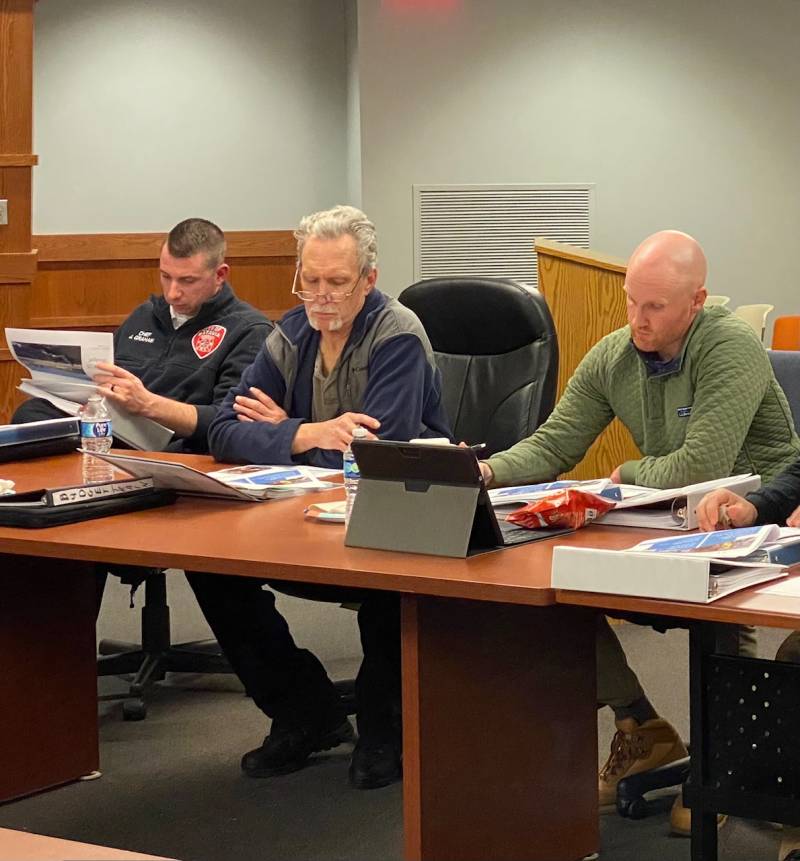
Photo by Joanne Beck
Wednesday’s city budget session was fairly short and sweet compared to a recent meeting — as City Fire Chief Josh Graham laid out his department's stats and recent insurance rating for a subdued City Council — and the group continued its way through a proposed $37 million financial plan at City Hall.
Graham explained his $4,696,860 2025 proposed budget, an increase of $286,583 from the 2024 adopted budget.
Of the 2,653 incidents to occur in 2023, nearly 68 percent of the call volume involved emergency medical services, Graham said. The department has experienced a 57.5 percent increase in call volume over the last 13 years, from 2010 to 2023, with the same number of 36 firefighters, he said, and six out of eight officers are eligible for retirement or will be within the next two years.
As for personnel, he told council to keep in mind that there may be two firefighters “that we have to push through the academy,” and retirement costs added an extra $140,000 to the budget.
Three new members joined the department in 2023, and it requested mutual aid a dozen times that year, three times less than called upon for mutual aid, responding 15 times.
He pointed out the length of careers for the entire team, with a fairly even split among those firefighters at two years and less, three to 10 years and 11 years or more.
“So if you wanted to look at the actual numbers from 2010, all the way up to 2023, you can pretty much see the line that goes across there, with 2020 being that dip during COVID. Obviously, the run numbers went down the next page just shows the career lengths, which I thought was kind of interesting because we're right at about one-third, one-third and one-third,” he said. “We're pretty green for our fire department, but because we have such a stellar staff of officers and those mid-level senior firefighters, it all worked out pretty much 33 percent right across the board.”
So what does the city fire department do?
Emergency medical services, fire suppression, motor vehicle accidents, hazmat, ice and swift water, rope and confined space rescues; firefighter assist and search team; fire prevention and fire extinguisher training; building inspection/code enforcement; car seat checks and installations; community service events/standby; emergency medical technician and related training; fire investigations; smoke and carbon monoxide detector installations.
August was the busiest month in 2023, at 249 calls, with May and November tying for the lowest calls of 193. Firefighters apparently could get some sleep between 3 to 4 a.m., since that was the least busy time, at 44 calls, but not at 10 a.m., when activity reached its peak at 163 calls, still lingering at 161 calls between 11 a.m. and noon.
The department responded to 63 structure fires, 80 motor vehicle accidents, 351 alarms, 85 hazardous conditions, 108 service calls, and 1,804 needs for emergency medical services.
The department arrived on scene within six minutes, 90 percent of the time, with an average response of less than four minutes. A response time of 10 to 11 minutes occurred in 19 percent of the calls, while nearly half of them were between three and five minutes.
His wish list includes a replacement of portable radios and pagers, which would cost $200,000 if purchased all at once. However, he suggested an $8,700 increase to the communications budget line to purchase or fix those pieces of equipment. Pagers are used to notify off-duty staff for recall, and the radios were last purchased with a grant through the county around 2015-16, he said.
“We were hoping that there would be another grant and we could start replacing the radios, but that's not coming to fruition. So in order to replace the entirety of our radios, you're looking at just short of $200,000. So this is an attempt to try to start cycling those out, as opposed to replacing them all at the same time,” Graham said. “They are just aging out. They may be broken … so if they do break, and the radio costs, you know, $2,000 to fix it, but it's $4,000 for a radio, do you pay the $2,000 to fix it? Or do you get the three newer versions for $4,000?”
He said that video lottery terminal funds could be used to replace 10 portable radios, “and will get us well on our way to replacing them.”
The department already received its Christmas present: a nearly $800,000 fire engine that, with assistance from grant funds, will gradually be paid off over the next two decades in debt service payments. It’s that apparatus and all else owned by Batavia, and the number of staff that went into account for its public classification insurance ranking of “03,” which means the city is “considered highly protected,” Graham said.
Per a letter sent to the city, this ranking is important to communities and fire departments because, as the rating improves, those communities “may get lower insurance prices.”
When asked by a council member how a department earns a “2” or a “1,” Graham said the top number is extremely hard to get, and it takes “high dollar things to improve the three rating,” he said.
There are 31,867 departments at a four or worse, he said.
